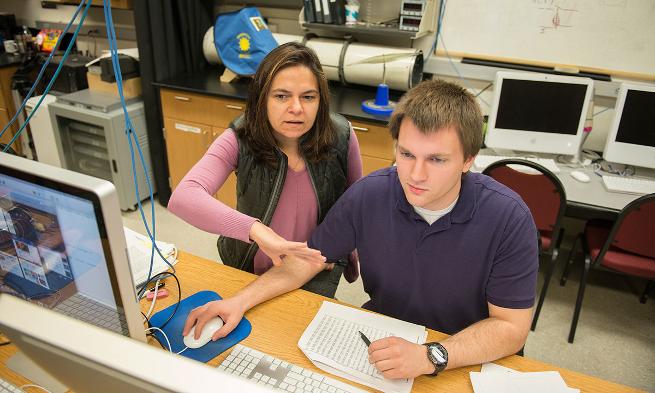Amazing megamasers: JMU researcher pursuing 'holy grail of astronomy'
Science and Technology
Scientists are on the verge of unlocking answers to two of astronomy's biggest questions and a JMU researcher is right in the middle of it.
Dr. Anca Constantin, an assistant professor of physics and astronomy, recently received a $10,000 grant from the Jeffress Memorial Trust to continue working on her part of the project - finding water megamasers suitable for measuring distances from earth to the galaxies they reside in and for measuring the mass of their galaxy's supermassive black hole.
"For the whole history of astronomy, we wanted to get estimates of these," said Constantin, who has received several other grants for the research and who is part of the National Radio Astronomy Observatory's Megamaser Cosmology Project.
"We do have some other methods for weighing supermassive black holes, but this method gives us the most accurate estimate on how massive they are," Constantin said. As for measuring distances to galaxies in the outer reaches of the universe, certain megamasers - those located near the supermassive black hole in the center of their galaxies and whose water molecules produce the emissions - provide the most accurate distances ever. "We know many things about how the universe looks geometrically, but it's not going to be as accurate as the distance given by this information," she said. "It's a direct method."
An astrophysical maser is similar to a laser, which stands for light amplification by stimulated emission of radiation. The difference is that maser emissions are typically in the microwave portion of the electromagnetic spectrum while laser emissions are in the visible light portion of the spectrum. Dr. James Braatz, who leads the Megamaser Cosmology Project, described masers as the radio-frequency equivalent of lasers.
Because megamaser emissions are not visible to optical telescopes, they are observed through radio telescopes such as the Green Bank Telescope, the world's largest fully steerable radio telescope, located just two hours southwest of Harrisonburg in Green Bank, W.Va. Finding the right kind of megamaser to make the measurements is a challenge, especially since there are hundreds of billions of galaxies in the universe. That's where Constantin comes in, with her research identifying properties of galaxies that host megamasers.
"There seems to be a Goldilocks region for a bunch of properties, like the rate of accretion of matter onto that supermassive black hole has to be in a certain narrow range, the density of the material in the nuclear region needs to be in a certain narrow range, the galaxy can't be too big or too small, the star population can't be too old or too young," she said.
Added Emil Christensen, a junior physics major who is assisting Constantin with the research and with a paper they are writing about the research, "We try to find out what makes them tick, why they are there."
Water megamasers that are formed in disk-like configurations are like "holy grails of astronomy," Constantin said. "If it's in a disk, we can actually map the rotation of the disk. It's actually a very simple mathematical model that any planet would follow in its orbit around its sun," she explained. "So you fix mathematically those positions and velocities of those masers and you can obtain the most accurate measurements of how massive the thing in the middle is, and that is the mass of the supermassive black hole."
And if the disk is face-on, simple geometry can be used to measure the distance to the galaxy, she said.
Megamasers are relatively new to astronomers, having been discovered about 50 years ago, and water megamaser disks have been rare finds. So far, only about eight megamaser disks with the right properties for making the measurements have been discovered. More are needed to improve the accuracy of the results so knowing where to look is vitally important. "We just don't have the time, the money to point these radio dishes toward all of these galaxies," Constantin said. "We're just never going to find them. We need to be more efficient in our search."
The way to do that, she said, is by comparing the properties of the galaxies where they have been found to the properties of galaxies known to contain maser emissions. So far, there are about 150 galaxies with detected maser emissions and about 40 of those seem to show promise for having the right properties.
"It's not easy," Constantin said, explaining that researchers have to mine the data captured by the telescopes to find what they're looking for. "It's a lot of work, but it's amazing when you find something."
"It's very incremental," Christensen said of his search through various databases and literature. "We learn a little bit of the puzzle, a very little bit. But it is important. And if somehow we get something that really can narrow it down, we find a lot of them, then statistically, a certain fraction of them are going to be useful."
And that information could be very useful to answer another burning question in astronomy - how do galaxies form? "What's the relationship between the galaxy and the black hole in the center? It's like a chicken or the egg question, what came first, the black hole or the galaxy?" Constantin said. "There are some hints that they co-evolved."
By Eric Gorton ('86,'09), JMU Public Affairs
Related Links:
